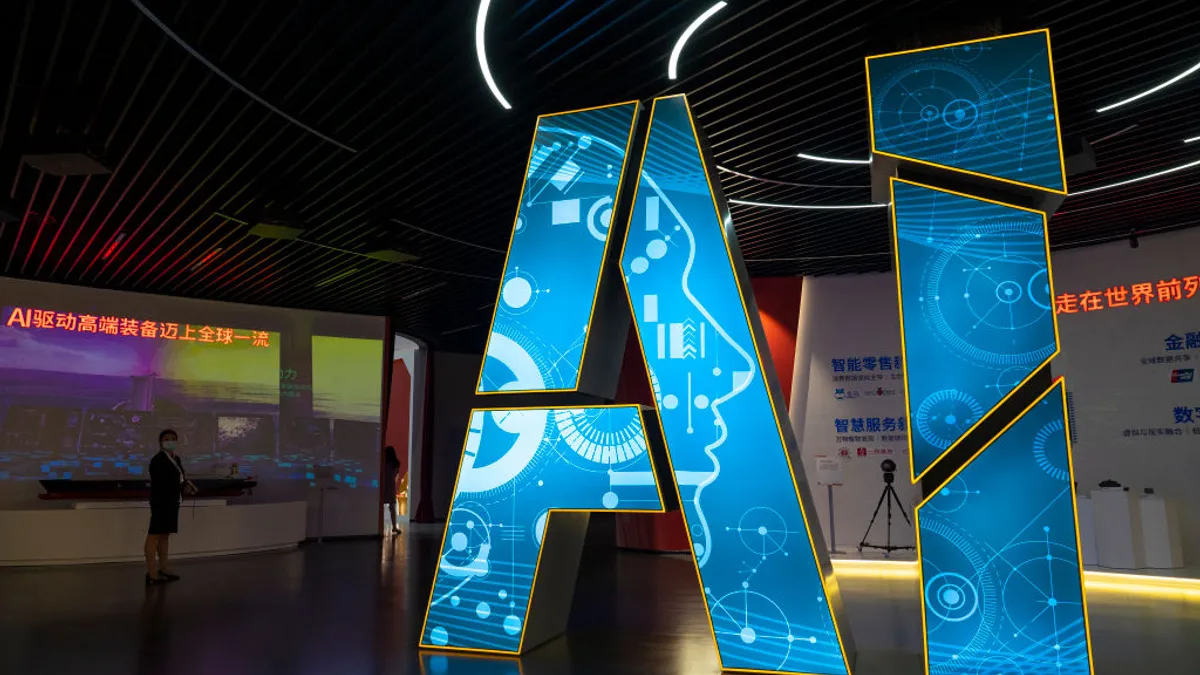Talent scarcity continues to challenge employers going into 2021's final months. HR executives have advised their industry peers to, among other things, avoid overreacting to the problem. But employers also could use the present moment to rethink hiring on a broader scale to prepare for the future.
That was the common thread shared between speakers at an Oct. 26 Talent Forward event presented by the U.S. Chamber of Commerce Foundation. Over more than three hours of discussion, executives, nonprofit leaders and advocates hammered out a verbal guide to the Great Resignation.
Contending with a pandemic, high turnover and a lack of skilled talent, HR Dive identified four strategies that panelists commonly cited during the event.
#1: At the local level, dig deeper pipelines
Industry observers have previously stressed the importance of targeting potential talent early, be it at the high school level or earlier.
"We need to get tools into people's hands earlier," said Christopher Griffin, CEO of USG Corporation, a Chicago-based construction material manufacturer. Griffin, who began his career hanging Sheetrock, described the influence of vocational programs he participated in during high school.
Employers could further this work by forming partnerships with education institutions such as community colleges and building hands-on programs for those who are either looking to advance in their careers or transition to new careers. "We think this can scale," said Siemens North America President and CEO Barbara Humpton.
For example, Siemens is building new forms of electrical car chargers at one of its North Carolina facilities, Humpton said. That has led the company to create an apprenticeship program at Wake Technical Community College in Raleigh, and Siemens has extended program spots to local high school juniors.
Others are seeking progress on youth empowerment. Judaline Cassidy, founder and chief visionary officer at New York nonprofit Tools & Tiaras, said her organization has had success in giving young girls experience with sheet metal work, ironworking, plumbing and carpentry, among other hands-on activities.
"I've found that the girls really respond to that," Cassidy said. "We physically put tools in girls' hands, and that empowers them to another degree that they realize, 'I can do anything.'"
Cassidy shared the example of one of her organization's youth advisors, a teenager who last year wrote a blog about the significance of her first welding experience at a Tools & Tiaras workshop. That same participant is now enrolled in an engineering program.
The organization has opened up its programming to women of all ages. After Tools & Tiaras held a women's workshop that showed participants how to install plumbing, six participants went on to become apprentices.
"We have to put the tools in their hands and support organizations that are actually doing that if we want to change the mind of girls, their parents, their community and the country," Cassidy said.
#2: Look within
Humpton added that although the term "great resignation" is often invoked to describe the state of today's talent market, she has spoken with leadership about a different concept — the "great reassignment." In other words, employers should not discount the role that internal mobility can play in giving employees what they want.
"If we want to retain our very best, it would be wise to give them what they're asking for."

Barbara Humpton
President and CEO, Siemens North America
"If it's true that people have in these last months searched their souls and decided that they want to do something different; well, maybe 'different' could be offered right here within the Siemens Corporation," Humpton said. "Perhaps there's someone who has been doing a job in software development and wants to switch into a cyber role. Maybe there's someone who's been a frontline technician who would like to get into the field of finance. We have the ability to make that happen within our walls."
"If we want to retain our very best, it would be wise to give them what they're asking for," Humpton said.
#3: Leverage inclusivity, expand your reach
The pandemic had a particular impact on women in the workforce, and for industries like technology that had already failed to hire female talent, that may mean an even bigger focus on diversity and inclusion work.
"You look in the fields that we're working in and seeing the same stories play out over and over again," Humpton said. One manufacturing industry executive observed the possibility that the industry could fill its extensive talent gap by cutting down its gender gap. Siemens is looking to organizations like Fairygodboss and Bossmaker to help its recruiters "reach an audience who perhaps didn't even know about Siemens and, I'd say, people who haven't thought about entering the fields our customers care so much about."
Organizations need to think about their traditional hiring habits and how those practices may have contributed to weeding out diverse candidates, according to Kwasi Mitchell, chief purpose officer at Deloitte US. Deloitte, for example, has taken a closer look at requirements that job applicants have a traditional, four-year college degree in favor of a skill-based approach.
Employers can also ensure that pathways for advancement are transparent and consider diverse employees "before they hit the doorway," said Maurice Jones, CEO of OneTen, an organization that focuses on the hiring, upskilling and promotion of Black workers. "A lot of the focus is on hiring and hiring people back," he continued. "The focus really needs to be on the trajectory of the talent — hiring, upskilling and advancing — and there needs to be a plan from day one for that journey."
#4: Even if flexibility seems impossible, consider it
Flexibility could play a key role in that work, given the pressures the pandemic placed on working parents. In Siemens manufacturing facilities, Humpton said managers have been challenged to think about creating more flexible arrival and departure schedules.
Meanwhile, child care is a "foundational need" of the U.S. workforce, said Christine Sharkey, president of Corning Enterprises, but employees in many parts of the country simply do not have access to quality, affordable child care. Parents, she added, are essentially forced to choose between providing a safe environment for their children or continuing to work.
"We need jobs, we need housing and we need transportation, but without child care, nothing else happens," said Alessandra Lezama, CEO of child care database TOOTRiS. "It's the sticky glue that holds all of our communities together. If working parents don't have the very comprehensive need met of having their children in a great program where they have peace of mind, they're simply not going to be productive."
As with many pandemic-driven challenges, employers have approached the child care problem from more than one angle. Amid lockdowns, Corning turned one of its office buildings into a virtual learning support center, Sharkey said. This allowed the company's manufacturing employees, many of whom could not work from home, to put their kids into a safe, supervised environment while they went to work.
Employers need not necessarily follow the exact same route in developing their own solutions, but they also can directly connect workers with day care centers or similar facilities. But the problem is too big to ignore outright, Sharkey said; "remember, employees will always choose the health and well-being of their children over working for you, so get out in front of it."





















